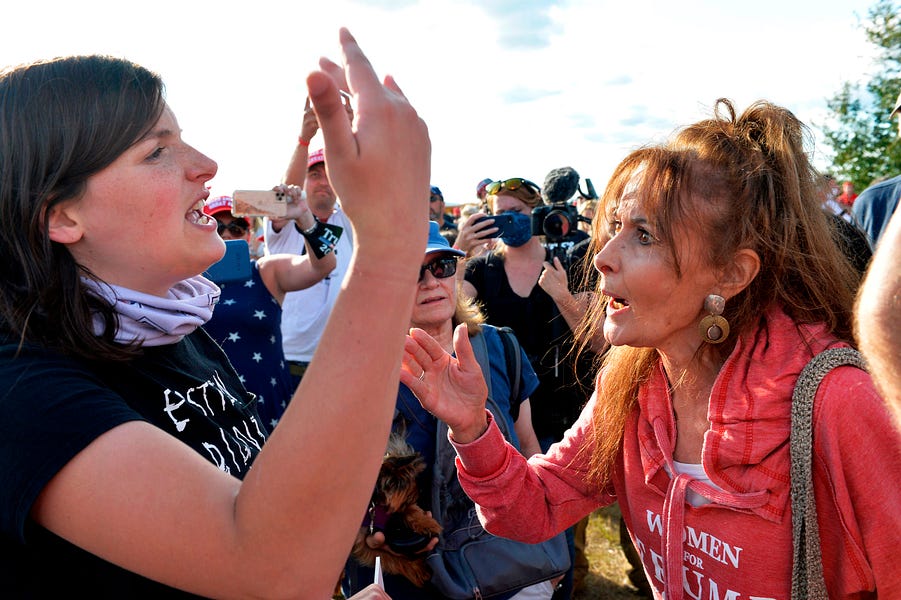The intensity surrounding the coming election, the nastiness of the debates and general rhetoric, and the unending protests and rallies and even regattas in support of President Trump paint a picture of a very polarized nation. Our divisions are real—and concerning—but some context is needed.
What we see in the electoral and social zeitgeist of the day is not representative of all of the nation’s 330 million citizens. The truth is that extreme voices and institutions have an outsized influence on our discourse and political focus, but there remains a significant number of centrists in the country who are not as engaged or closed minded as the more extreme voices. Those centrists can play an important role in elevating our discourse. Let me explain why.
Fox News, the most watched network on TV during the primetime hours of 8-11 p.m., averages 3.6 million primetime viewers, followed by second-place MSNBC’s 2.2 million. Twitter appears to be everywhere, but just 6 percent of U.S. adults on Twitter account for 73 percent of political tweets, and these voices mostly disapprove of Trump and tend to be extreme liberals in their own bubble. Robin DiAngelo’s controversial book White Fragility: Why It’s So Hard For White People to Talk About Racism has sold about 800,000 copies. These numbers are small when looked at as a percentage of population.
Meanwhile, the more moderate and open views of large numbers of Americans are not being heard. These people might not be worried about the latest brouhaha with the New York Times editorial board or which public figure just got “canceled” after old bad tweets were uncovered. Instead, they believe that government paralysis and dysfunction is a huge problem for the nation. Further, our citizens are not impressed or happy with either party to the point that relatively small numbers of Americans believe that either party’s policies are moving the country in the right direction.
Consider that moderates plus those who haven’t thought much about ideology make up roughly one-third of the population, while those who describe themselves as either extremely liberal or conservative comprise just about 10 percent. Data from a new national study as part of AEI’s Survey Center on American Life shows these disparities in political engagement as we head into November.
When asked whether they had made statements of public support for a political campaign on Facebook, Twitter, or other social media in the past year, for instance, just more than a quarter of moderates said they had. But the figure doubled for ideologues, with 52 percent of extreme liberals and 47 percent of extreme conservatives saying they had. With respect to attending a political rally, protest, speech or campaign event, huge differences emerged here as well. While just 9 percent of moderates showed up for some event, 28 percent of extreme liberals and 18 percent of extreme conservatives had. And the media regularly shows celebrities and activities wearing clothing—like a shirt, hat, or a bag—with a political message. (At least when those celebrities aren’t taking off their clothing to make a political statement.) But only 10 percent of moderates have done this, compared with a quarter of extreme liberals (26 percent) and a third (33 percent) of extreme conservatives. Similar trends emerge when it comes to reaching out and contacting elected officials, donating money to causes and campaigns, and displaying yard signs.
But the new survey data reveals something else important in regards to understanding our polarization and foul political discourse: Those Americans on the extremes have attitudes that treat politics as core to their identity while most moderate, Americans do not.
For instance, the survey examines whether or not a person’s political views say a lot about what kind of person they are; that is, can someone judge one’s character from one’s politics. Among moderates, only 10 percent “completely agree” that politics and character are so tightly linked, but that figure more than triples on the extremes. As much as they might disagree on politics, extremists on both sides are similar when it comes to one thing: 35 percent of each “completely agree” that ideology and character are deeply coupled.
When “somewhat agree” with this idea is included, the divisions grow where three-quarters of ideologues compared to just over half of centrists tie political views with character.
Now, let’s talk about echo chambers. The survey wanted to know whether respondents were prompted to question some of their assumptions after talking to people with different political views than their own.
The differences are, again, substantial. While almost half of moderates (48 percent) find themselves questioning their assumptions, less than a third of extreme liberals (31 percent) and 8 percent of extreme conservatives acknowledged doing the same thing.
Relatedly, the survey data show that when more extreme ideologues talk about politics with people with whom they disagree, they have encounters that are far more stressful and frustrating rather than interesting and informative compared to moderates. No wonder extremists limit their exposure and live in bubbles: 71 percent of extreme liberals and 61 percent of extreme conservatives find dissonance grating. In contrast, less than half of moderate identifiers feel this way, and the other half are open and find disagreement interesting and informative.
These new data reveal why politics has become so ostensibly divisive and polarized; there is a loud and engaged group of extreme ideologues who have an outsized voice despite their small numbers and a large group of reasonable and thoughtful centrists who are far less engaged and divisive. This latter group needs to start speaking up and demand that America live up to its values of working with dissimilar others and hearing the other side. The silent center has ceded too much ground and agenda to the extreme, and America has become a world where the minority rules over the majority. It does not have to remain this way.
Samuel J. Abrams is professor of politics at Sarah Lawrence College and a visiting scholar at the American Enterprise Institute.
Photograph by Joseph Prezioso/AFP/Getty Images.






Please note that we at The Dispatch hold ourselves, our work, and our commenters to a higher standard than other places on the internet. We welcome comments that foster genuine debate or discussion—including comments critical of us or our work—but responses that include ad hominem attacks on fellow Dispatch members or are intended to stoke fear and anger may be moderated.
With your membership, you only have the ability to comment on The Morning Dispatch articles. Consider upgrading to join the conversation everywhere.